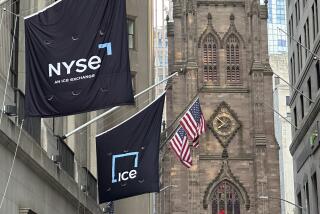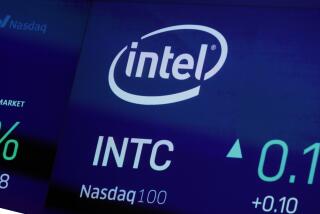Major Chip Makers Ready to Slash Jobs
- Share via
Major chip companies, including Japan’s Toshiba Corp., are preparing to slash tens of thousands of jobs worldwide, anticipating that deepening price cuts and faster products won’t be enough to stimulate demand in the near future.
Toshiba, the second-largest semiconductor maker after Intel Corp., said Monday that it will eliminate 17,000 jobs in Japan and 1,800 elsewhere in the next three years, reducing its work force by about 10%.
Hitachi Ltd., Japan’s third-biggest chip maker, is planning cuts of about 20,000 jobs, Japanese media reported. Fujitsu Ltd. said last week that it will trim 16,400 jobs, or 9% of its work force, mostly outside that nation.
News of the layoffs overshadowed Intel’s shipments Monday of its Pentium IV chip, the fastest PC semiconductor ever. Intel executives said the new chips, though moderately priced, and the imminent release of Microsoft Corp.’s new Windows XP operating system won’t generate a dramatic increase in computer sales in the fourth quarter.
In Japan, where the unemployment rate hit 5% in July for the first time since the government began compiling such statistics in 1953, the dramatic job cuts underscore the depth of the problems for processor and memory chips aimed at a variety of devices.
“As a manager, I feel a heavy responsibility,” Toshiba President Tadashi Okamura told reporters. “My mission is to revive the company and ensure everyone develops a strong sense of crisis.”
The Tokyo-based company said it would lose as much as $958 million this year instead of posting a previously projected profit. The company also is in talks to combine its memory-chip business with that of Infineon Technologies of Germany, Infineon said. Toshiba declined to address that issue Monday. Prices of dynamic random access memory, or DRAM, have plummeted in the last year.
Toshiba said about half of the domestic job cuts, or about 10,000 positions, will come through attrition. The company’s North American microchip business, Toshiba America Electronic Components, cut 29 full-time jobs out of a total of 635 on Monday, including 19 at its Irvine headquarters, a spokeswoman said. Toshiba’s other Orange County operations, which produce computers, copiers, medical devices and other products, were unaffected. The company employs 188,000 workers worldwide.
Officials said that by March 2004, Toshiba will have reduced the number of plants in Japan to 15 from 21. The company didn’t say what kind of factories it wants to shut.
Mami Indo, an analyst with Daiwa Institute of Research in Tokyo, said Toshiba sorely needed the job cuts.
“This time, the company is finally tackling the problem it wasn’t able to touch upon in the past,” Indo said. “But how Toshiba will start achieving growth remains to be seen.”
Toshiba’s U.S.-listed shares slipped 10 cents to $4.70 Monday in over-the-counter trading. Hitachi rose 39 cents to $85.39 on the New York Stock Exchange, while Fujitsu gained 75 cents to $52.25 in OTC trading.
Intel’s Pentium IV is the first-ever 2-gigahertz chip for a personal computer, meaning that they run at 2 billion cycles per second. That is 50% faster than the most powerful chip of Intel’s top U.S. competitor, Advanced Micro Devices Inc.
That “clock speed” is one thing that enables computer users to perform increasingly popular, data-intensive tasks such as digital design, photo manipulation and video and music editing more quickly.
A rebound in the computer sector requires a pickup in the economy as well as new reasons to buy, said Intel Vice President Louis Burns. He is sticking by earlier projections of a slight improvement at the end of this year and potentially faster growth next year.
Intel said this year it would shutter a Puerto Rican factory employing 1,100 and eliminate another 3,900 positions, mostly through attrition, by the end of 2001. The company has about 88,000 employees. A spokesman said those plans haven’t changed.
This weekend, Intel slashed prices on its earlier versions of the chip by up to 54%. The aggressive move was a blow to rivals such as AMD, but the lower prices won’t spur a PC recovery until the second half of next year, said analyst Mark Edelstone of Morgan Stanley.
Intel said computer makers would be able to put slower, 1.5-GHz Pentium IV chips in machines costing as little as $800, effectively killing off desktop demand for the Pentium III by the end of the year.
In announcing the new chip at a San Jose conference Monday, Intel said its new architecture would be enough to get speeds five times that fast in years ahead.
That’s strong incentive for hardware and software developers, who can design products around the Pentium IV without worrying about starting over when Intel switches to a new architecture.
But the plan is bad news for AMD, which has steadily taken market share with cheaper chips that are nearly as fast as Intel’s. AMD’s desktop computer share increased from 12% to 22% in the last two years, according to Dan Niles of Lehman Bros.
“We believe that Intel’s new price cuts and speed grades will enable them to maintain, if not take back, market share through the rest of this year in desktops,” Niles wrote in a research report.
At the moment, the fastest Intel chips cost $562 in quantities of 1,000, with 1.9-GHz versions priced at $375. Edelstone said that few corporate buyers would pay the higher price for something just 10% faster.
More price cuts will come in late October, he said. Intel is scheduled to give another financial forecast Sept. 6. Intel shares rose 7 cents to $29.15 on Nasdaq. AMD gained 30 cents, to $15.30, on the NYSE.
*
Times staff writer E. Scott Reckard and Times wire services contributed to this report.
More to Read
Inside the business of entertainment
The Wide Shot brings you news, analysis and insights on everything from streaming wars to production — and what it all means for the future.
You may occasionally receive promotional content from the Los Angeles Times.










